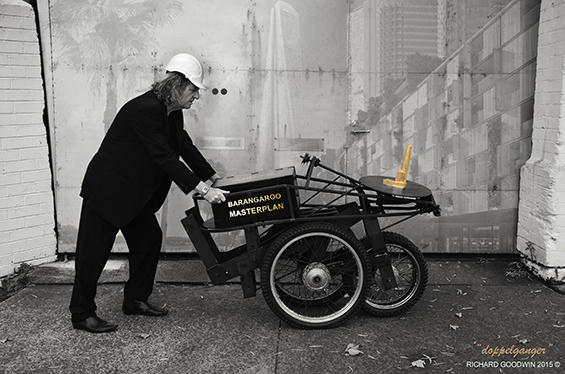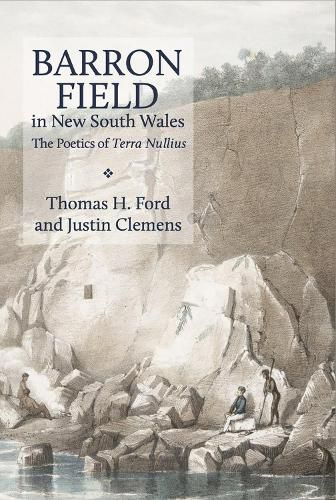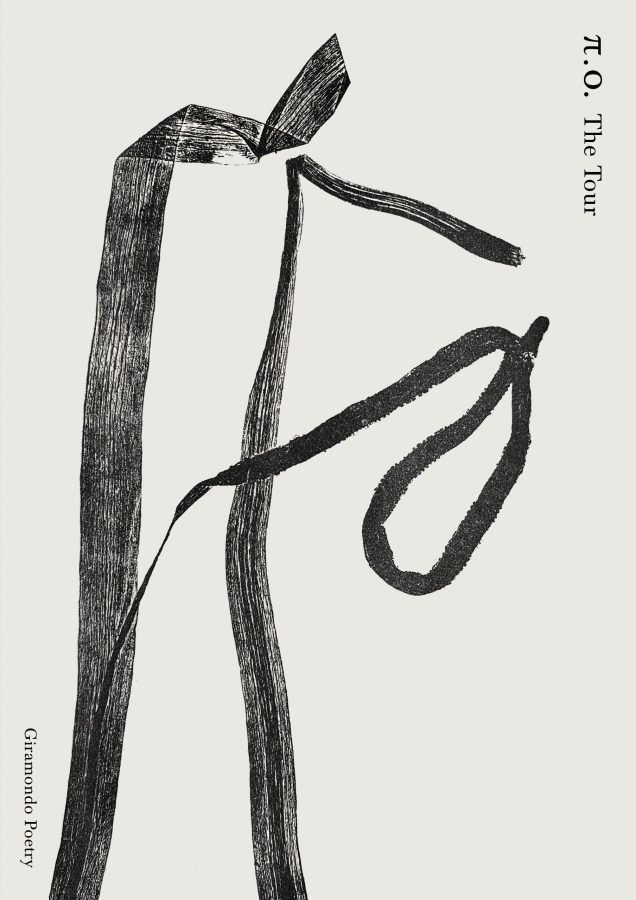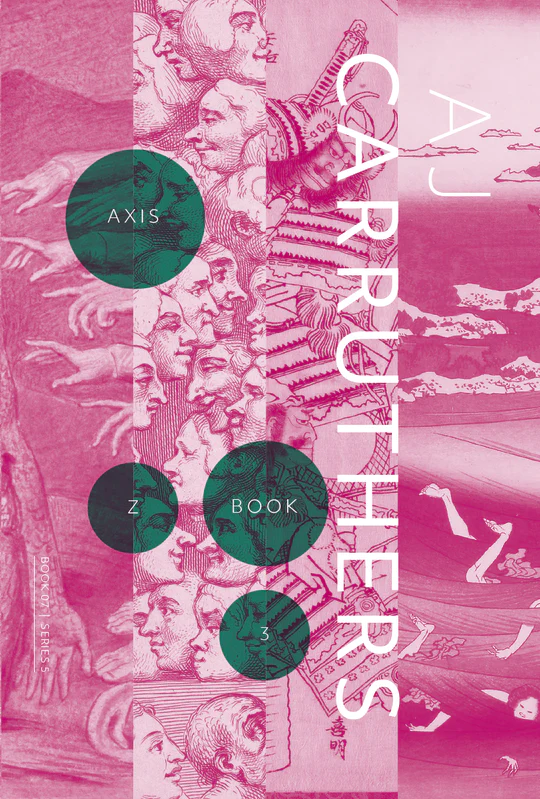
Richard Goodwin, Barangaroo Doppelganger Performance, April 16th 2015 – April 16th 2016, courtesy of the artist and Australian Galleries.
The idea that poetry is more difficult than fiction has a lot to do with the failure to recognise that a different method of reading is required by each. A collection of poems is typically 96 pages in length. A novel could be anywhere between, say, 250 and 500 pages. If you allow the same time for the reading of each – on the basis that the same degree of effort has gone into the writing of each – then, simply on that basis, you would have to accept that a page of poetry requires three to five times the attention given to a page of fiction. You should feel easy with the prospect of reading a poem many times, in the process of weighing its implications, in contrast to the largely single and forward-directed reading you give to a novel. It obviously isn’t appropriate to recommend a collection of poems, as they do a novel in the marketplace, on the grounds that it is a page-turner. But the assumption that poems should lend themselves to the same kind of reading as fiction seems to be widespread, and is likely to make even the most direct poems appear difficult and intractable.
It is common, however, to blame the poet. The often-heard complaint is that modernism made poetry inaccessible, a strange idea given that there can hardly be an adult in the country who, having completed high school, has not been exposed, on an institutional basis, to the poems of T. S. Eliot. A more recent and local version of the complaint lays the blame at the feet of those poets who, in a fit of revolutionary gusto in the 1970s, overturned the proprieties, and supposedly the poetic clarity, of the previous generation – Judith Wright, Rosemary Dobson, James McAuley, David Campbell, Gwen Harwood, A. D. Hope. Included in this group of ‘difficult’ poets are John Tranter, John Forbes, Alan Wearne, Gig Ryan and Joanne Burns.
In her recent review of Joanne Burns’ collection Brush in the Sydney Review of Books, Jessica Wilkinson began by suggesting that Burns had wilfully forsaken clarity for the ‘head spin’ and ‘rampant verbal flowering’, then noted that, after three readings, ‘an alternative clarity emerged, one that artfully purified a contemporary experience – media saturation, information overload, advertising bombardment, excess consumption, political vertigo and decay’.
Gig Ryan’s poetry has seemed just as intimidating to some. In their massive anthology Australian Poetry Since 1788 (2011), Geoffrey Lehmann and Robert Gray left Joanne Burns out. They included a parsimonious selection of three Ryan poems, the longest of which, ‘If I Had a Gun’, had been published in her first collection, The Division of Anger (1980), over thirty years before. It has been much anthologised since then, for it has the status of a feminist anthem. In that sense, its inclusion was a no-brainer. In Ryan’s early poems, they noted, ‘there is an unstoppable joie de vivre although the voice is angry’. They went on: ‘Since then Ryan’s poetry has become increasingly reflective and fragmented, less accessible and sometimes elegiac, but the reader senses an undiminished, cauterizing power.’
This qualified praise, largely on the grounds of energy, seems small justice for a poet who is one of the most expressive in the language – joie de vivre and excoriation would seem to mark only two rather vague positions in what is a wide range of emotional and ethical concerns. The characteristics of Ryan’s poetry are an often rapid alternation of images and perspectives, which enacts the fluctuating tempo of feeling; a dramatic (and sometimes operatic) ‘throwing’ of scenes; a highly gestural use of language and syntax; and, since these techniques concentrate and intensify, an accompanying process of resonance and implication, which both amplify and deepen the emotional affect.
Ryan doesn’t have to go far for her expressive material: it is readily to hand in the vernacular, in overheard conversations, since ordinary Australian speech packs its intensities into incomplete or hesitant bursts. Hence ‘Eating Vietnamese’, which is set in a restaurant:
This restaurant’s divine. They’re refugees
Asians are beautiful don’t you think, quite hairless
She wore apricot chiffon There were kids everywhere
So demanding. Am I missing?
I guess you’re going to soon
These places make me horny
It’s honest to see the way they kill
Ryan’s poems often make use of found tags and ‘hip’ phrases, and it is their clipped quality, their gesture towards what is not articulated, that gives them their power. But there is another kind of resonance, more literary, in which the poem evokes other poems, or other poets, or other powerful pieces of writing. Difficulty in reading is the opposite of resonance, it is experienced as an exclusion, a denial of sense. Resonance on the other hand, brings other voices into play, you become party to a conversation. These are the climactic lines of the poem ‘Forfeit’:
I look west to the horizon’s walls of brass
and seem to see my sod and quick life frittered
in denizens of quasi-love, curriculum,
and rail against the stones, the bright blue oscillating sea
and breathe hope’s cud whereby my gain, lover’s lack
that doped me, sweat and plaques
that lounged my shady stew
that splits my life’s purchases like a sack
and go with the ‘appointed to tribulation’
The creaking parched water saddles and repents
He moans across the oceans and his voice was like a pilaster.
There is a scriptural quality to the rhetoric here (explicitly acknowledged in the cited phrase ‘appointed to tribulation’) but more specifically, because the poem is a soliloquy, resonances of Shakespeare. These resonances are even more strongly felt in the second poem of Ryan’s included by Lehmann and Gray, the sonnet ‘When I consider’:
When I consider what my life has been
the tightening streets that stuck me to their side
the turning penitential globe inscribed
with gold and thorn, I picket what I’ve seen
as if the will were new, the heart were keen
before despair became where you abide
alone with cold ideals and clinging pride
acts and dreams spread out across the screen
I pause…
These first eight lines give you the octet of the sonnet, with a tight rhyme scheme (abba, abba), tighter even than that employed in the Shakespearean sonnet (abab, cdcd). And at the ‘turn’ of the sonnet, the poet dutifully pauses – quite literally so in this case.
There is no obscurity in the literary gesture here at all. Ryan’s sonnet begins in exactly the same way as Milton’s sonnet on his blindness, ‘When I consider how my light is spent’ and Shakespeare’s sonnet 15, ‘When I consider everything that grows / Holds in perfection but a little moment.’ Shakespeare often begins his sonnets with ‘When…’ – appropriately, given their obsession with time and death.
When forty winters shall besiege thy brow
and dig deep trenches in thy beauty’s field
(Sonnet 2)When I do count the clock that tells the time,
and see the brave day sunk in hideous night’
(Sonnet 12)‘When to the sessions of sweet silent thought
I summon up remembrance of things past
(Sonnet 30)
The elegiac beat, acknowledging and resisting the march of time, is unmistakeable too. Ryan’s poem is therefore shadowed, not just by Sonnet 15, but by the form and rhythm of Shakespeare’s sonnet sequence as a whole, with which it remains in dialogue throughout. That is quite an amplification for a quiet poem.
There are intimate, personal glimpses – the ‘tightening’ streets; the Catholic references to the crucifixion and the sacred heart, ‘inscribed / with gold and thorn’; the use of colloquial expressions – ‘that stuck me to their side’, ‘I picket what I’ve seen’ – which intensifies the physical experience on the one hand, and the ethical stance toward the spectacle of the past on the other, signifying the resurgence of vitality and principle in the face of despair. Yet here too you sense the Shakespearean resonances – the motif of life as a spectacle played out upon a stage (the screen in this case), the distant or indifferent lover, the ambiguous syntax William Empson delighted in, in the examples he took from Shakespeare’s sonnets in Seven Types of Ambiguity (1930), fittingly represented here by the line, ‘before despair became where you abide’, where despair goes two ways, so that the line could mean either ‘before you (the poet, the lover) came to dwell in despair’ or ‘before despair grew in the place where you dwell (in my heart or mind)’.
Here, to end with, is the sestet of the sonnet, which begins with Ryan’s take on the Shakespearean sunset which heralds the end of life and time:
I pause at the silky prolonged sunset
that death or god should taper off and shrink
as all the city’s woes and all the skies
say not to remember but to forget
and chafing through the cars I fall to think
how sorrows lift and pleasures cauterise
Aficionados will recognise the use of paradox or oxymoron favoured by Shakespeare, particularly at the end of his sonnets – ‘And all in war with Time for love of you / As he takes from you I engraft you new’ in the case of Sonnet 15; ‘This thought is as a death, which cannot choose / But weep to have that which it fears to lose’ in Sonnet 64; and perhaps most famously in Sonnet 73:
This thou perceiv’st, which makes thy love more strong,
To love that well which thou must leave ere long.
Ryan’s version – ‘and chafing through the cars I fall to think / how sorrows lift and pleasures cauterise’ – is even more complex, partly because the possibility of irony reverses the obvious meaning, even as it is asserted – that is to say, the poem sees its own melancholy mood not as uplifting at all, but as an act of self-indulgence; pleasure, if you could get it without guilt or self-recrimination, would be a lot more satisfying. On the other hand, it is true, there is nothing quite as expansive and elevating as the descent into melancholy. It is the source of great poems.
*
With Anzac Day upon us, this week Sydney Review of Books features an essay by Greg Lockhart on two recent histories of the Australian war experience: Joan Beaumont’s Broken Nation: Australians in the Great War, which was joint winner of the 2014 Prime Minister’s Award, and Douglas Newton’s Hell-Bent: Australia’s Leap into the Great War. In ‘Imperial Romance’, Lockhart argues that Australian accounts of the Great War have been shaped by the myth that the nation entered that conflict on the basis of a political consensus, an idea that Newton’s account refutes. Beaumont’s celebrated book, however, ‘remains committed to the romance of the national-imperial consensus of 1914’. Though Broken Nation is a major work of synthesis, its consensus view
depends on suppressing the story of the tensions and deceptions in Australian defence history and the underlying anxieties about race. Masked by her liberal voice and the rhetoric of horror, those suppressions define Broken Nation and its unwitting efforts to write the nation out of history. To a considerable extent, this is also the story of the social history literature she has synthesised.
Our second essay this week is Charlotte Wood’s ‘Across the Face of the Sun’, a reflection on a classic of Australian literature, Shirley Hazzard’s novel The Transit of Venus. There has been a renewal of interest in Hazzard’s work in that last few years. It has been the subject of a major study by Brigitta Olubas, Shirley Hazzard: Literary Expatriate and Cosmopolitan Humanist, and more recently Olubas has edited a substantial volume of critical essays on Hazzard that has brought together some of Australia’s most eminent literary scholars, including John Frow, Gail Jones, Brigid Rooney and Robert Dixon. Wood’s feature essay is an edited version of a lecture given last month at Sydney University as part of the Sydney Ideas’ Reading Australian Literature series. Its personalised reading of The Transit of Venus considers the novel’s theme of self-sovereignty, its variegated depictions of the experience of womanhood, and its extraordinary ability to upend expectations and alter the perspective of its readers.
From the Archives this week looks at the Anzac myth from another perspective. In ‘Statues with Blind Eyeballs’, Tim Corballis examines the art of the photographer Laurence Aberhart, whose images of war memorials in Australia and New Zealand seek to draw our attention to the contrast been the object that is being photographed and the context in which it located. The focus on forgotten objects in Aberhart’s work, argues Corballis, highlights ‘the mismatch between what is left and what is remembered. Objects can remain and yet be forgotten. It is a virtue to look at them again.’





